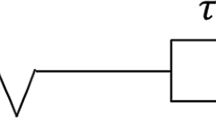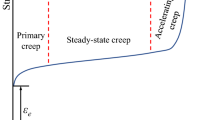Abstract
The creep model is the main form of rock model used to describe the rheological behavior of rocks. A large number of creep models have been proposed, but many are complicated and/or are not able to fully simulate the three stages of rock creep. Hence, an important focus of research on rock creep has been to develop a model with few parameters and better simulation performance. To achieve this, in this study, we propose a new four-element creep model, based on variable-order fractional derivatives and continuum damage mechanics. The newly proposed creep model agrees well with experimental data for Changshan rock salt. The results show that the segmentation treatment is an effective approach for simulating the creep behavior of rocks.











Similar content being viewed by others
References
Adolfsson K, Enelund M, Olsson P (2004) On the fractional order model of viscoelasticity. Mech Time-Depend Mat 9(1):15–34
Atanackovic TM (2002) A modified Zener model of a viscoelastic body. Contin Mech Thermodyn 14(2):137–148
Blair GWS (1947) The role of psychophysics in rheology. J Colloid Sci 2(1):21–32
Cao WG, Yuan JZ, Wang JY et al (2013) A damage simulation technique of the full rock creep process considering accelerated creep. J Hunan Univ Nat Sci Ed 40(2):15–20
Chakrabarti R (2012) Dynamics of end-to-end loop formation for an isolated chain in viscoelastic fluid. Phys A 391(391):5326–5331
Chen H, Xu W, Wang W et al (2013) A nonlinear viscoelastic–plastic rheological model for rocks based on fractional derivative theory. Int J Mod Phys B 27(25):5514–5518
Fabre G, Pellet F (2006) Creep and time-dependent damage in argillaceous rocks. Int J Rock Mech Min Sci 43(6):950–960
Friedrich C (1991) Relaxation and retardation functions of the Maxwell model with fractional derivatives. Rheol Acta 30(2):151–158
Jaishankar A, McKinley GH (2012) Power-law rheology in the bulk and at the interface: quasi-properties and fractional constitutive equations. Proc R Soc A 20120284. doi:10.1098/rspa.2012.0284
Kang JH, Xu MY (2009) An exact solution for flow past an accelerated horizontal plate in a rotating fluid with the generalized Oldroyd-B model. Acta Mech Sin 25(4):463–469
Kang J, Zhou F, Liu C et al (2015) A fractional nonlinear creep model for coal considering damage effect and experimental validation. Int J Nonlin Mech 76:20–28
Nedjar B, Roy RL (2013) An approach to the modeling of viscoelastic damage Application to the long-term creep of gypsum rock materials. Int J Numer Anal Meth Geomech 37(9):1066–1078
Qiu X, Jiang Y, Yan Z et al (2003) Creep damage failure of rock salt. J Chongqing Univ 26(5):107–109
Schiessel H, Metzler R, Blumen A et al (1995) Generalized viscoelastic models: their fractional equations with solutions. J Phys A Math Gen 28(23):6567–6584
Tan WC, Pan WX, Xu MY (2003) A note on unsteady flows of a viscoelastic fluid with the fractional Maxwell model between two parallel plates. Int J Nonlin Mech 38(5):645–650
Wu F, Liu JF, Wang J (2015) An improved Maxwell creep model for rock based on variable-order fractional derivatives. Environ Earth Sci 73(11):6965–6971
Yang T, Fang B (2013) Asymptotic analysis of an axially viscoelastic string constituted by a fractional differentiation law. Int J Nonlin Mech 49(1):170–174
Yin DS, Yan QL, Hao WU et al (2013) Fractional description of mechanical property evolution of soft soils during creep. Water Sci Eng 6(4):446–455
Acknowledgements
This work was supported by the National Science Foundation of China (grant no. 41130745). The authors wish to thank the colleagues who contributed to this work.
Author information
Authors and Affiliations
Corresponding author
Rights and permissions
About this article
Cite this article
Tang, H., Wang, D., Huang, R. et al. A new rock creep model based on variable-order fractional derivatives and continuum damage mechanics. Bull Eng Geol Environ 77, 375–383 (2018). https://doi.org/10.1007/s10064-016-0992-1
Received:
Accepted:
Published:
Issue Date:
DOI: https://doi.org/10.1007/s10064-016-0992-1




